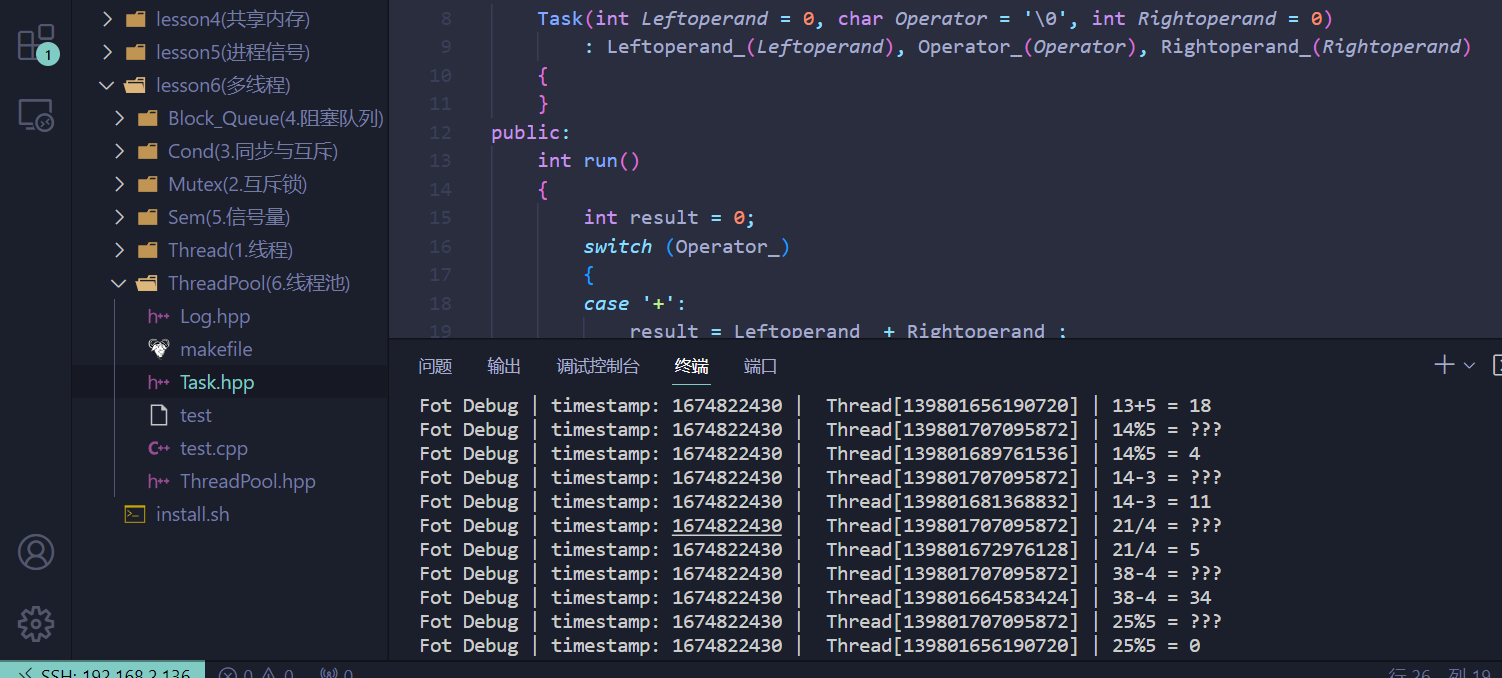🌈前言
这篇文章来实现一个线程池!!!
🍨线程池概念
-
线程池
-
- 一种线程使用模式
-
- 线程过多会带来调度开销,进而影响缓存局部性和整体性能。而线程池维护着多个线程,等待着监督管理者分配可并发执行的任务
-
- 这避免了在处理短时间任务时创建与销毁线程的代价
-
- 线程池不仅能够保证内核的充分利用,还能防止过分调度。可用线程数量应该取决于可用的并发处理器、处理器内核、内存、网络sockets等的数量
应用场景
-
- 需要大量的线程来完成任务,且完成任务的时间比较短。 WEB服务器完成网页请求这样的任务,使用线程池技术是非常合适的。因为单个任务小,而任务数量巨大,你可以想象一个热门网站的点击次数。 但对于长时间的任务,比如一个Telnet连接请求,线程池的优点就不明显了。因为Telnet会话时间比线程的创建时间大多了
-
- 对性能要求苛刻的应用,比如要求服务器迅速响应客户请求
-
- 接受突发性的大量请求,但不至于使服务器因此产生大量线程的应用。突发性大量客户请求,在没有线程池情况下,将产生大量线程,虽然理论上大部分操作系统线程数目最大值不是问题,短时间内产生大量线程可能使内存到达极限,出现错误
线程池种类
-
- 创建固定数量线程池,循环从任务队列中获取任务对象
-
- 获取到任务对象后,执行任务对象中的任务接口
🍨线程池的实现
makefile
test:test.cpp
g++ -o $@ $^ -std=c++11 -lpthread
.PHONY:clean
clean:
rm -rf test
Log.hpp – 打印日记,用于debug
#pragma once
// 用于debug -- 打印日志
#include <iostream>
#include <ctime>
#include <pthread.h>
std::ostream &Log()
{
std::cout << "Fot Debug |" << " timestamp: " << (uint64_t)time(nullptr) << " | " << " Thread[" << pthread_self() << "] | ";
return std::cout;
}
Task.hpp – 任务类 – 用于派发任务
#pragma once
#include <iostream>
// 设置一个计数器任务
class Task
{
public:
Task(int Leftoperand = 0, char Operator = '\0', int Rightoperand = 0)
: Leftoperand_(Leftoperand), Operator_(Operator), Rightoperand_(Rightoperand)
{
}
public:
int run()
{
int result = 0;
switch (Operator_)
{
case '+':
result = Leftoperand_ + Rightoperand_;
break;
case '-':
result = Leftoperand_ - Rightoperand_;
break;
case '*':
result = Leftoperand_ * Rightoperand_;
break;
case '/':
if (Rightoperand_ == 0)
{
std::cout << "Divide by zero error! ! !" << std::endl;
result = -1;
}
else
{
result = Leftoperand_ / Rightoperand_;
}
break;
case '%':
if (Rightoperand_ == 0)
{
std::cout << "Modulo by zero error! ! !" << std::endl;
result = -1;
}
else
{
result = Leftoperand_ % Rightoperand_;
}
break;
default:
std::cout << "Illegal operator: " << Operator_ << std::endl;
break;
}
return result;
}
public:
// 仿函数
int operator()()
{
return run();
}
// 输出型函数 -- 获取私有成员
void GetMemberVal(int* p1, char* p2, int* p3)
{
*p1 = Leftoperand_;
*p2 = Operator_;
*p3 = Rightoperand_;
}
private:
int Leftoperand_; // 左操作数
char Operator_; // 加减乘除字符
int Rightoperand_; // 右操作数
};
ThreadPool.hpp – 线程池实现 – 注释讲解
#include "Log.hpp"
#include <iostream>
#include <queue>
#include <cstdlib>
#include <unistd.h>
#include <pthread.h>
// 线程池 -- 启动一堆线程,等待任务到来,来任务就派发线程去执行任务
// 优先:提高效率,提前启动线程
// 设置方案:启动N个线程 -- 执行线程处理函数 -- 函数里面加锁判断队列是否有任务(条件)
// -- 没有任务则在条件变量下阻塞等待,有任务则到pop函数拿任务
// -- push函数用于加载任务,并且让条件变量就绪,唤醒线程,处理加载的任务
const int TNum = 5; // 默认设置线程数据为5个
template <typename T>
class ThreadPool
{
public:
// 构造函数与析构函数
ThreadPool(int ThreadNum = TNum) : IsStart(false), ThreadNum_(ThreadNum)
{
// 线程数量不能小于或等于0
if (ThreadNum_ < 0)
{
std::cout << "The number of threads cannot be less than 1 " << std::endl;
exit(1);
}
pthread_mutex_init(&Pmutex_, nullptr);
pthread_cond_init(&Pcond_, nullptr);
}
~ThreadPool()
{
pthread_mutex_destroy(&Pmutex_);
pthread_cond_destroy(&Pcond_);
}
public:
// 线程处理任务函数 -- 设置全局处理函数 -- 类成员函数包含隐藏this指针
static void *TaskProcess(void *args)
{
// 线程分离 -- 线程执行完任务后,自动释放资源,主线程不用等待
pthread_detach(pthread_self());
ThreadPool<T> *tpp = static_cast<ThreadPool<T> *>(args);
while (true)
{
tpp->lockQueue(); // 加锁
while (!(tpp->IshaveTask())) // 判断是否有任务,有返回1,没有返回0
{
// 没有任务就在条件变量下阻塞等待,等待push加载任务后唤醒
tpp->waitForTask();
}
// 这个任务就被拿到了线程的上下文中
T t = tpp->pop();
tpp->unlockQueue(); // 解锁
// ....下面是并发的处理任务 -- 约定好任务必须有run成员函数
int result = t.run();
int Leftoperand;
char Operator;
int Rightoperand;
t.GetMemberVal(&Leftoperand, &Operator, &Rightoperand);
// 打印日志 -- debug
Log() << Leftoperand << Operator << Rightoperand << " = " << result << std::endl;
}
return nullptr;
}
// 启动多线程
void StartUpThread()
{
if (IsStart != false)
{
std::cout << "Error: Start thread repeatedly! ! !" << std::endl;
exit(2);
}
for (int i = 0; i < ThreadNum_; ++i)
{
pthread_t tid;
// 这里传this指针,是因为处理函数是在类里面(类成员函数包含隐藏this指针)-- error: 类型不符合
pthread_create(&tid, nullptr, TaskProcess, this);
}
// 启动完成,更新IsStart为true
IsStart = true;
}
// 加载任务
void push(const T &val)
{
// 加锁 -- 加载任务 -- 派发任务给线程 --解锁
lockQueue();
threadpool_.push(val);
WakeUp();
unlockQueue();
}
private:
void lockQueue() { pthread_mutex_lock(&Pmutex_); }
void unlockQueue() { pthread_mutex_unlock(&Pmutex_); }
void WakeUp() { pthread_cond_signal(&Pcond_); }
void waitForTask() { pthread_cond_wait(&Pcond_, &Pmutex_); }
bool IshaveTask() { return !(threadpool_.empty()); }
// 线程处理任务后,需要在队列中删除任务 -- 并且返回这个任务(处理函数要对任务进行处理)
T pop()
{
T val = threadpool_.front();
threadpool_.pop();
return val;
}
private:
bool IsStart; // 防止重复启动线程
int ThreadNum_; // 线程数量
std::queue<T> threadpool_; // 线程池
pthread_mutex_t Pmutex_; // 互斥锁
pthread_cond_t Pcond_; // 条件变量
};
test.cpp
#include "ThreadPool.hpp"
#include "Task.hpp"
#include <memory>
#include <string>
#include <ctime>
using namespace std;
int main()
{
unique_ptr<ThreadPool<Task>> tp(new ThreadPool<Task>());
string OperatorSet = "+-*/%";
tp->StartUpThread();
// 设置随机数种子 -- 按位异或是为了更随机一些
srand((unsigned long)time(nullptr) ^ getpid() ^ pthread_self());
while (true)
{
int Leftoperand = rand() % 50; // 取值范围:[0, 40)
char Operator = OperatorSet[rand() % OperatorSet.size()];
int Rightoperand = rand() % 10; // 取值范围:[0, 10)
Task t(Leftoperand, Operator, Rightoperand);
Log() << Leftoperand << Operator << Rightoperand << " = " << "???" << std::endl;
tp->push(t);
usleep(10000);
}
return 0;
}























 663
663











 被折叠的 条评论
为什么被折叠?
被折叠的 条评论
为什么被折叠?








